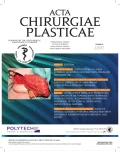Editorial
Published in the journal:
ACTA CHIRURGIAE PLASTICAE, 59, 2, 2017, pp. 55
Category:
Editorial
Dear colleagues,
Medicine would not progress without new data and we would not have new data without critical thinking and science. Science is accountable for any progress. We would still be using adipofascial grafts for breast augmentation, we would cease using silicone breast implants due to a fear of breast cancer or connective tissue diseases, we would not have any perforator flaps, and would not know any objective data on the quality of life of our patients or objective data on fat grafting performance.
The most important part of plastic surgeon’s professional life takes place at the operating room. However, in order to achieve the best possible care of our patients, we need something more. We need to pursuit academic carrier, be active in science, publish or we are going to perish. The responsibility lies not only on the leaders of plastic surgery, but on each individual plastic surgeon, whether he or she just harvests fruits or is giving something back.
Continuous education of a plastic surgeon is a must. Without it, his or her skills would slowly become obsolete. In my opinion, the best education, that ensures staying up to date, is to create own content – teaching, presenting at conferences, writing books or articles. This forces people, even if they do not want to, to dig into archives of plastic surgery and to study newest available data on a particular subject. Therefore I encourage you to present or publish, for example in Acta chirurgiae plasticae, which is a journal with more than 50 years of tradition providing the newest content to Plastic Surgery Society.
Great news is that number of submissions to our journal increases along with their quality. Here we present second issue of the year 2017, which is full of interesting articles from renowned authors from several countries across the World.
Article by Dr. Bukovcan is discussing lower extremity wound complications in patients with warfarin use, their incidence and treatment approaches. Article by Elshazly and al. involves research that compares suture vs. glue for micro neural anastomosis on an animal model. Dr. Streit offers two articles in fat grafting topic. First one describes technique of breast reconstruction using extended latissimus dorsi flap and direct fatgrafting into latissimus dorsi and pectoral muscles. In the second article, he offers an overview of current concepts of autologous fat transfer to breast and face. Another overview is written by Dr. Kaiser describing current concepts in peripheral nerve injury repair. Di Lorenzo at al. describes author’s preferred technique to correct labia minor hypertrophy using reduction of labia minora and fat grafting to labia majora. Last, but not least, article by Dr. Pilný describes case series of rare glomus tumor, including its diagnostics and treatment.
I wish you a pleasant reading.
Assoc. Prof. Ondřej Měšťák, M.D.
Department of Plastic Surgery
Hospital na Bulovce and the First Faculty of Medicine, Charles University
Štítky
Chirurgie plastická Ortopedie Popáleninová medicína TraumatologieČlánek vyšel v časopise
Acta chirurgiae plasticae

2017 Číslo 2
- Metamizol jako analgetikum první volby: kdy, pro koho, jak a proč?
- MUDr. Lenka Klimešová: Multioborová vizita může být klíčem k efektivnější perioperační léčbě chronické bolesti
- Neodolpasse je bezpečný přípravek v krátkodobé léčbě bolesti
- Léčba akutní pooperační bolesti z pohledu ortopeda
Nejčtenější v tomto čísle
- CHIRURGICKÁ KOREKCE HYPERTROFIE LABIA MINORA, OSOBNÍ TECHNIKA
- Přenos tukové tkáně do m. pectoralis a m. latissimus dorsi – nový přístup k autologní rekonstrukci prsu založený na laloku latissimus dorsi
- Komplikácie poúrazových hematómov dolných končatín u warfarinizovaných pacientov
- Bývá glomus tumor diagnostikován časně?

